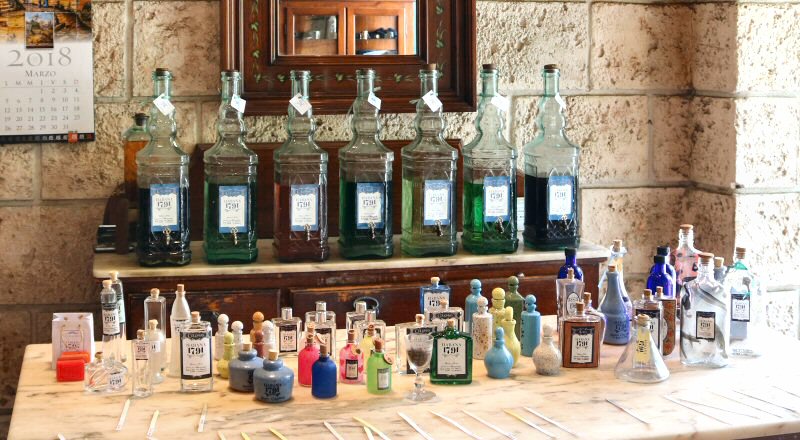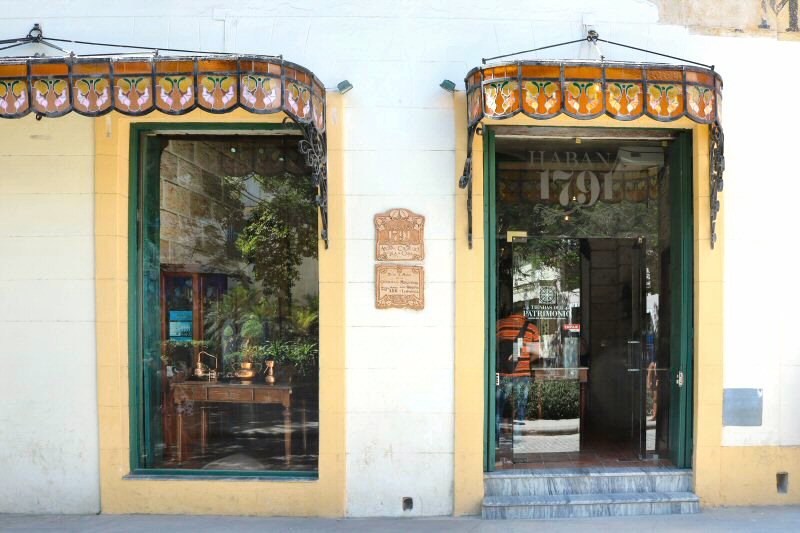

HISTORY
The building of the Perfume Museum was
built in the 17th century. Dr. Lázaro de Flores, the prestigious
doctor of the time, was one of its owners. He was also the
author of the book Arte de Navegar (The Art of Sailing), the
oldest scientific work on navigation written in Cuba (1672). In
the 18th century, the rooms were leased separately to different
persons, such as the prominent pharmacist Don Pedro Sanfeliú. In
the mid-19th century Marquesa de Aguas Claras, Countess of
Villanueva, became the owner of the house and installed here the
renowned drugstore Botica y Almacenes de Santa Rita
(1868-1880). At the end of the 19th century, one part of the
building has been bought by Don José Cánovas del Castillo,
Governor of the Spanish Bank of the Island of Cuba. In the 20th
century the house was rebuilt and acquired its neo-classical
façade, but still continued being leased by its owners, so that
it became a deteriorated tenement house that underwent
considerable modification in its interior. After an extensive
restoration that started in 1990s, the building was rescued and
the old perfumery was inaugurated under the name of Perfumería
Habana 1791 by the Cuban perfumer Yanelda Mendosa that had
trained in Grasse, France, in the capital of perfume, in 2000.
It is also known as Perfume Museum, as
19th century jars of the brands, such as Guerlain, Shalimar,
Johnson, and even a container of Agua de Colonia by the Italian
Jean Marie Farina, dating from the first half of the 19th
century, are exhibited in the shop. The museum has a collection
of French perfumes, as well as the products of some Cuban
perfumers, predating 1960, like Gravi, Sebatés, Crusellas and
Suchel Camacho.
At the entrance the stained-glass marquee in warm tones is the work of the Cuban glass master Rosia María de la Terga. Everything at the reception takes us back to a distant past: the 18th century copper objects that belong to the collections of the City Museum, the large censer, the rustic furniture, the candles, the glass and ceramic containers of different size. Ceramic flasks of the Velásquez Vigil family and others made by members of the Terracota 4 group constitute exclusive containers for liquid aromatics.
THE PERFUMERY
The Perfumería Habana 1791 is a
specialized shop that sells perfume, elaborated by means of
artisanal distillation processes of local tropical aromatic
plants. You can even see the petals drying in the laboratory at
the back of the shop. With the delicate glass instruments,
marble mortars, huge decanters, baskets with dried plants and
large bottles with macerated pedals inside, the laboratory has
unique atmosphere. The fragrances are produced according to the
rescued original formula from the colonial time. The recipes are
scribbled on the walls. The process of producing a perfume
starts with manual harvesting of the petals. Then they are kept
with the stems of tropical flowers in large glass bottles for
the maceration. After the pulverization of the dried material,
the intermediary product is mixed with distilled water and 50
percent alcohol.
In this perfumery 12 varieties of scents
or colognes are sold, such as rose, jasmine, violet, orange
blossom, lilac, ylang-ylang, patchouli, vetiver, sandalwood,
tobacco, citric and lavender. You can also find other, more
intriguing scents, such as gardenia. Customers are invited to
try out the ready-made colognes and perfumes. Mendosa’s favorite
perfume Habanera is very sensual and feminine. You can choose
also the unique perfume with the signature Habana 1791 that is
reported to be the oldest scent created in the city. The
perfume of mariposa, a white floral that is the national flower
of Cuba, is also sold a lot.
Custom-made scents can be also created
according to the customer’s desire. A short dialogue with the
customer aids the perfumer to discover the character, mood and
expectation of the customer, so that the most appropriate
mixture of more than one scents can be prepared that would exalt
the sense of the customer.
The colourful perfume bottles are also
handcrafted. Some of them are made by Cuban ceramists, the
virtuoses of the Asociación Cubana de Artesanos Artistas (Cuban
Association of Craftsmen Artists), while others are imported,
particularly from India. They are reproduced in the original
design in which the fragrances were filled. You can choose any
of them. They have a maximum capacity of 50 ml, and their price
ranges from 7 to 20 CUC. The perfumes are held in massive glass
containers; they are poured into the individual perfume bottles,
when they are ordered. They are corked and sealed with wax.
Although they are securely packaged, be sure to wrap them in
plastic as they may slightly leak out. Once the bottle is
sealed, the label with a small verse about flowers, will be
stuck.
Except the essences that cure and
alleviate the spiritual ailments, such as anxiety, stress,
melancholy, and can be used to control moods (aromatherapy),
some perfumed soaps, a variety of sachets with petals of
flowers, leaves of tobacco and bark of the lemon, perfumed
massage oils are also on sale in the shop.
Through the double doors that lead to the garden, the visitors will reach some therapy rooms where they can get a massage with any of the perfumed oils. Prices vary according to the treatment requested. A facial massage costs about 15 CUC; meanwhile, for 25 CUC you can get a full body message. Procedures, such as facial depigmentation, moisturizing, regenerating, anti-aging, acne therapy, are also available.

The Perfumería Habana
1791 is located on the Mercaderes street #156, at its
intersection with the Obrapia street.

